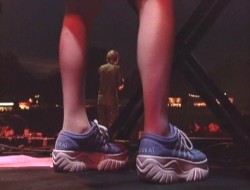
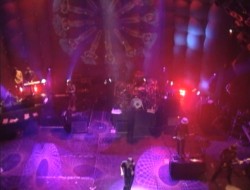
View From The Crew
Words: Suw Charman, Images: The Park Is Mine DVD
Taken from Melody Maker, 8 August 1998


The magic of Jarvis' secret switch, a stash of Neneh Cherry records, and the little known Warhol amplifier. It must be Pulp live.
'Castle Pulpditz' says a small sign next to the entrance to the dressing room enclosure backstage at Finsbury Park. It surely can't be a dig at security who, round the front, are thoughtfully throwing cups of water out to a crowd who've been slowly incinerating under an unreasonably hot sun. The crowd, equally thoughtfully, have been busy too, launching said vessels of water with surprising accuracy at the knot of hapless photographers loitering in the pit, also waiting for Jarvis to sashay forth.
The band and crew, meanwhile, have more pressing matters on their mind, like the small matter of a gig. Justin Grealy, for example, is more concerned about Jarvis' unusual microphone manoeuvrings. "On a couple of songs," he says, "Jarvis uses a vocal mic with a little microswitch which enables him to stack through the effects programmes. He's using a Digitech Studio Vocalist and a Roland VT1 Voice Transformer, a little vocal effects pedal, and there are varying combinations of these used in different songs to the extent, in fact, that he switches effects between verses and choruses. Basically he uses them to play chords with his voice."
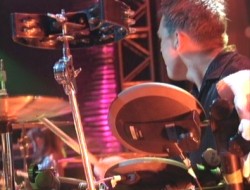
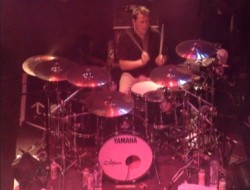
Nick Banks' drums and Steve Mackey's bass set-up are both presided over by Steve Prior. Nick's kit is a "fairly straight forward Yamaha Maple Custom," says Prior, "which comprises 13" rack tom, 16" floor tom, Yamaha Birch Custom snare and 22" kick, with Remo Pinstripes on the toms and Ambassador Batteurs on the snares. He's got more cymbals than you can shake a stick at: Zildjian A Custom 15", 16", 18", and 19" crashes, 22" inch K-ride, 8" K splash, 20" Oriental China, 14" Dyno Beat hi-hats and a heavy weight Zildjian Zil-Bel. We're using Yamaha DTX electronic drum pads as triggers for an Akai S3000 sampler. 'Seductive Barry' features the pads rather heavily, playing a keyboard sample loop, and the rest are various snare and sub-bass kick drum sounds. An Akai ME35 trigger module is used as an interface between the Yamaha pads and then all of the samples are cued by the main sample rack operated by Candida Doyle. Nick also uses a Shure FP22 headphone amp for a click, running from a Tascam DA88, for songs like 'A Little Soul', 'Glory Days' and sometimes 'Seductive Barry', where the loops feature rather heavily and the rest of the band need to look to him for time. They have a propensity for playing incredibly loud on stage, though, so quite often you can't even hear the click."
Doing a summer season of festivals brings it's own problems with setting up the kit on risers that are sometimes too small. "Nick needs to be able to access the sampler rack behind him which takes up a lot of space, so it's a matter of squashing him on but giving him enough room to flail his arms around a bit. Plus we have to leave a reasonable amount of space on the riser for Jarvis to jump on and off!"
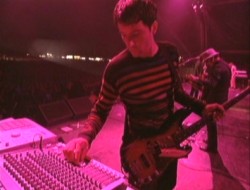
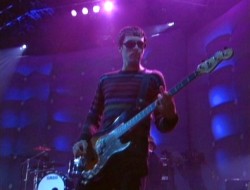
Steve Mackey uses a Fender US Custom Precision bass. "It's a fairly new model," says Prior, "which incorporates both the Precision and the Jazz bass pickups, so you have the best of both sounds from the single guitar. Then there's his old favourite, which is an old Musicman Sabre, one of the good ones rather than the newer Ernie Ball models. He generally uses it in only about three songs: 'Seductive Barry', 'Sorted for E's and Wizz', and the 'Glory Days/Common People' segue. The bass goes into an Ampeg SVT3 Pro pre-amp, then into a Ridge Farm Gas Cooker valve DI, a twin channel DI box which just makes it far warmer than a direct DI sound. From that it goes into an SWR300 power amp, which is in bits at the moment, having been dropped off numerous aeroplanes, but it's just about managing to keep working, and that then powers an Ampeg SVT 8×10 cabinet."
Mackey keeps his sound very simple, not using any effects pedals at all. "He's just very loud," says Prior. "He's not the biggest fan of new bass strings in the world, because they always sound too bright for him, but again it's volume: The brighter the bass strings the more trebly and twangy they are and it noticeably takes your head off, as opposed to being more of a kidney-melting rumble. Aside from his bass, Steve also does a bit of DJ-ing on couple of Technics decks and has an Akai MPC2000 Midi Production Centre, a 16-way Mackie mixing desk and an Alesis Quadraverb plus a couple of delays and effects processors. The acetates on the turntables were made specifically and mainly feature Neneh Cherry's backing vocals. Because she's too busy to actually come and sing live, she gave permission for him to mix in her vocal. He really only uses the decks in two songs, 'Seductive Barry' and 'Common People'."
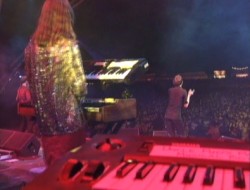
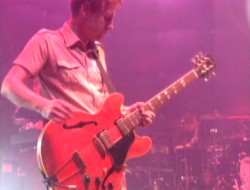
The band are very specific about what they want and the sound they're aiming for. "Rather than things being looped all the way through," explains Prior, "which would obviously make it more staid and predictable, they're playing in real time, triggering their own sounds. Because of the amount of different effects, vocal treatments and on-stage weirdness, it has to be fairly well-controlled. They do have very good ears - for how long I don't know, with the volumes they play at - but they definitely know what they want."
The guitars for Mark Webber, Jarvis and Richard Hawley, who's been drafted in for the live shows, are looked after by Mark Scott ('Scottie'). Mark uses a Gibson 345 Stereo, Les Paul Standard and a Gibson Firebird through a Marshall JCM 900 which has been restyled a "Warhol" for reasons unclear, and a Fender 1965 Twin 4x12. Mark has more than enough pedals to make up for any shortages elsewhere, with a preponderance of Lovetones: a Doppelganger, Meatball, Brown Source, and Big Cheese. Also nailed to the barn door that serves as pedal board are an MXR Phase 90, Boss Digital Delay, Coloursound Dod Equaliser, Tone Bender, Nobels Tremolo, and a Korg Wah. "Mark runs some effects off an effects loop," explains Scottie, "and some straight-lined into the amplifier. He plays quite strangely, he's definitely got his own sound."
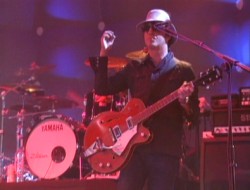
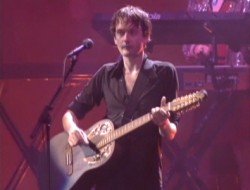
Richard favours Gretsch guitars, with a Tennessee and a Country Gentleman which he puts through a Marshall PowerBreak, a Roland Space Echo RE-201, and then a Peavey 5150 amp with matching cabs. His pedal board rivals Mark's, with a Digitech Whammy II, Univibe, MXR Phase 90, Dyna Comp, Boss TR2 Tremolo, Tone Bender Fuzz, Boss Compressor, Boss Bass Synth and a "Haw-wah II". Jarvis himself has three acoustics - a Harmony Sovereign six-string guitar, Ovation 12-string guitar, and a Yamaha six-string - which make occasional outings on 'Sorted for E's and Wizz', 'TV Movie' and 'Something Changed'.
The many and various keyboards and samplers played by Mark, Candida and Jarvis are cared for by Owain Lloyd. "Mark's got an Ensoniq ARS10 and a Fender Rhodes Stage," says Owain. "Candida's using a Memory Moog, Roland Vocoder Plus and Roland XP10, and occasionally a Farfisa Professional 2 which comes out less and less often because it keeps breaking. They're so rare, there are three in England and we know where they all are and the other guy won't give us one. Jarvis plays a Novation 10 - it doesn't have any sounds, it's just a MIDI controller which he uses on 'Seductive Barry', but he won't be playing that any more because he's just smashed it up for the second time!"
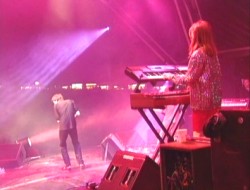
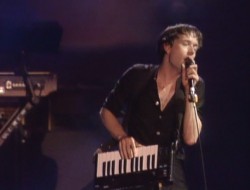
As well as the other samplers previously mentioned there are two Akai S3000XLs, three Akai S3000s, and a Tascam DA8. "The Farfisa, Memory Moog and the Vocoder are the only ones actually triggering their own sounds," says Owain. "Everything else is triggering samples. The only quirky thing is that no one plays with velocity or aftertouch, they all have all the sensitivity taken off the keyboards, I'm not sure why."
One of the few festi-style gigs to have lucked out on the weather this year, Pulp walk on stage to a lightly toasted yet ecstatically enthusiastic crowd. The spectacular is made more so by Dave Byers' stunning lights which have been not so much programmed as choreographed. Considering that what can go wrong probably will, and how much gear Pulp have that could go wrong, it seems almost a miracle that nothing expires and nothing explodes. Jarvis slinks around the stage, proving Pulp can still enrapture.
"The PA is the very nice SSE Nexo Alpha system" says Matt Butcher, the FOH engineer, "and we've got Amec Langley Recall desks. The Amec has its own built-in dynamics, but you have to have it preset, you can't do it on the fly, which is the great thing at festivals, to use your toes on the faders down the end and all that kind of stuff. The offboard effects include a Lexicon 480L which is a posh reverb that we like a lot, and an AMS RMX16 which is a bit of a classic late 70s English reverb. You tend to have to turn them on and off a lot, then they work for 20 minutes and then they go bang and you have to hit them."
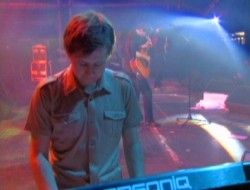
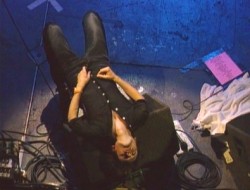
"The EQs is a TC Electronics TC1128 programmable analogue graphic," says Justin Grealy, the monitor engineer, "so you can modify and store a whole series of different EQs. I'm using 16 reasonably predictable mixes, as we have an extra keyboard player, a trumpet player and three backing singers. Steve likes a lot of loud bass guitar, kick snare, hi-hat, so I need a really serious speaker system. Mark has two sets of monitors one which is mostly keyboards. He plays Rhodes piano and does a lot of sample triggering, like the applause-y bits in 'Sorted for E's and Wizz' and the piano in 'Hardcore'.
Jarvis can be very difficult, because he runs all over the stage, climbs up the side fills, crawls underneath the drum riser, and plays around with the vocal microphone all of the time. He's very unpredictable. Roger Middlecoat, our stage manager, has the luxury task of getting out on stage and untangling the mic lead from the wedges and the guitars and everything else that he manages to tangle it up in. That's the problem with Jarvis - he spends as much time lying on the wedges as he does listening to them."